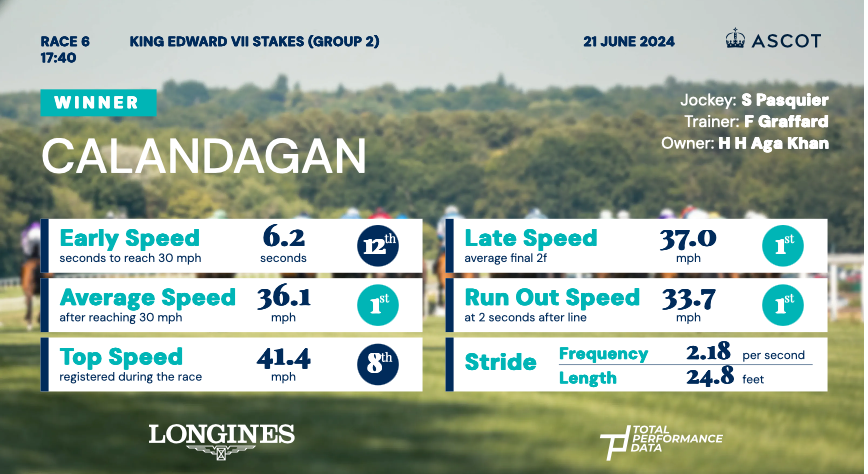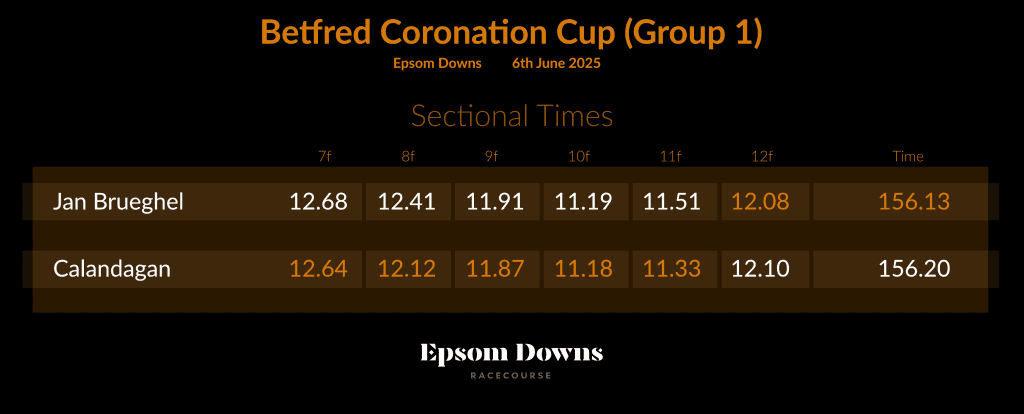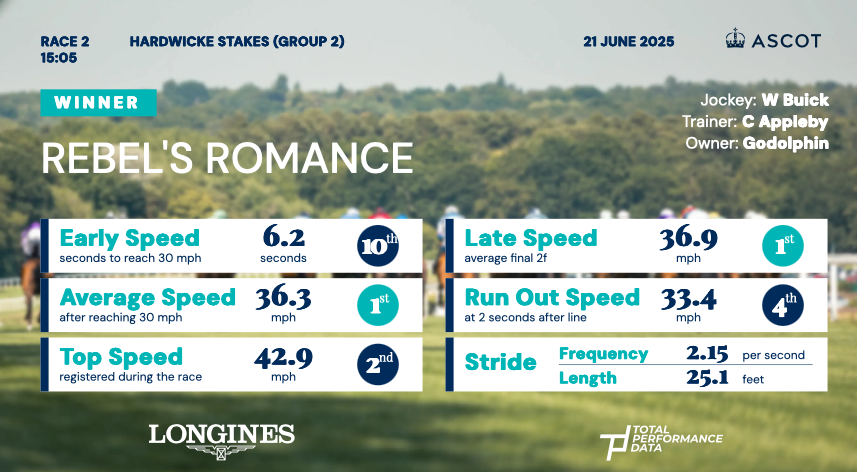King George VI and Queen Elizabeth Stakes
Imagine a race with the greatest middle-distance performers in the history of the sport on its roster. Mill Reef, Brigadier Gerard, Shergar, Dancing Brave, Nashwan, Galileo, Enable … .the list is endless and there are so many other great winners of the King George VI and Queen Elizabeth Stakes that I simply can’t fit into this preview. In the height of Summer, as the generations merge, this race is as close to the pinnacle of the sport as we can get. The 2025 renewal should meet such lofty expectations. We have a multiple G1 winner who has won on 3 continents, we have a Classic winner who has won 5 of his 6 starts and we have the best horse in training on the European continent. That’s just the head of the market. This race has the potential to be a race for the ages at Ascot on Saturday afternoon, but what can the data from TPD tell us about the contenders chances. Here’s a look at the key players;


Calandagan is the best middle distance horse in France. He’s come a long way since he demolished the field in last year’s King Edward VII Stakes at Royal Ascot, but I think that I can say with relatively strong authority now that he has won a Group 1 race that he is the best horse on the European continent. There may be those who would point to the fact that Goliath didn’t run his race in the Grand Prix de Saint-Cloud and that the ground was probably fast enough for the runner-up, but Calandagan came from last to first with closing sectionals of 10.76 and 11.29s to breeze past Aventure, an Arc de Triomphe runner-up who had won her previous 2 starts this season. That performance quickly put to bed any doubts about his attitude in the closing stages and a top speed of 41.75 mph would confirm the theory that he is the fastest horse in the King George VI and Queen Elizabeth Stakes. If this race were to develop into a sprint finish, he is the horse that is most likely to benefit, but that is a very big “if”. The victory at Saint-Cloud came over this 12-furlong trip, but a winning time of 2:28.28 was only par for the course, ranked 5th in winning times for that race since 2015 despite the quicker underfoot conditions. The race developed into a sprint finish, with a finishing speed of 110% and there is a definite school of thought that says Calandagan is a 10-furlong horse who stays a little further, rather than being ideally suited by Saturday’s distance.


I’ve approached the renewal of the rivalry between Calandagan and Jan Brueghel from the point of view of a boxing match between a pair of heavyweights. The first leg of the trilogy went to Aidan O’Briens horse, who dominated the race from start to finish in the Coronation Cup at Epsom, landing plenty of heavy blows in the climb to the top of the Epsom Hill. He was faster than Calandagan in just 4 of the 12-furlong splits that day, but he flew from the stalls with an opening furlong of 17.61s, immediately taking 0.78s out of his rival, a difference of around 5-lengths. The french horse has responded well, getting himself organised and recording the fastest individual split for 5 of the last 7-furlongs, but despite getting himself on terms, when it mattered, when it really mattered, Jan Brueghel found the knock out blow in the final furlong when he ran 12.08s with a run-out speed of 35.88 mph, both ranked 1st. Calandagan had the higher stride frequency, peaking at 2.6 strides per second down the hill, but Jan Brueghel had the longer stride at an average of 23.36 ft and by setting a fast pace, Ryan Moore was able to ensure that Calandagan’s speed was blunted in the final furlongs. At 40.58 mph, Jan Brueghel actually had the better top speed figure at Epsom and so the assumption that he outstayed his rival is not 100% confirmed, though as a St Leger winner, that is still the most logical conclusion. A finishing speed of 112.5% would confirm the thought that Jan Brueghel showed more speed than he is being given credit for.
Jan Brueghel also has the advantage of having a “second” in his corner. Continuous may have fallen a long way since his own St Leger win, but he has been employed as a pacemaker for his more illustrious stablemates and will be there when the stalls open to help ensure that Jan Brueghel is able to have the race run to suit. He went far too fast in the Prince of Wales’s Stakes at the Royal Meeting, running opening furlongs 13.25, 11.04 and 12.22s. To add some context to that pace, although it was on a different part of the track and we should acknowledge that fact, Continuous ran faster than the winner of the Royal Hunt Cup over those opening furlongs, despite the fact that the Hunt Cup is a full field mile handicap with an end-to-end gallop. That pace left Los Angeles with very little left in the tank and both of the Ballydoyle runners were soundly beaten by Ombudsman on the day, recording a run out speed of just 32.39 mph. It seems highly likely that the Ballydoyle team will have learned a lesson from that race and the combination of a smaller field and no obvious competition for the early lead should mean that Continuous is ridden with slightly more restraint. However, the presence of a pacemaker will help to ensure that this race doesn’t develop into a dash from the final bend. Aidan O’Brien has won this race 3 times in the last 20 years, but his last winner was Highland Reel in 2016 and he has had 35 runners in the field over that time period and he will be keen to try and give his horse the best possible chance to improve that record.
The stats would suggest that the top 2 in the market are the horses to concentrate on. A 4-year-old has won 10 of the last 19 renewals of this race and 9 of those 19 winners had won on their previous start. Jan Brueghel has not been to Ascot before, but that shouldn’t be a cause for concern given that 11 of the last 19 winners had not previously won a race at the Berkshire track. If the handicapper is correct, the pair of them should have too much for this field, but what about the other runners?


I think that we would all like to own a horse like Rebel’s Romance. The winner of over £10 million pounds of prize money, he has been a wonderful servant to Charlie Appleby and Godolphin and it would be a mistake to assume that he is vulnerable to younger legs. He won the Hardwicke Stakes over this course and distance at the Royal Meeting, getting the better of subsequent Curragh Cup (G2) winner Al Riffa. He ran the fastest final furlong that day in 12.38s, recording a top speed of 42.95 mph with the longest peak average stride length in the field at 26.31 ft. The conditions on Saturday are likely to be softer than they were last month, but his top speed and long stride would suggest that this race will be perfectly run to suit. He finished 3rd in this race 12-months ago, but that came in a race won in a winning time of 2:27.43, over 2-seconds quicker than the TPD Expected time for those conditions with a finishing speed of 95%. William Buick committed him for home too soon on that occasion, running the fastest 8th furlong in 12.17s and he couldn’t sustain his effort. The smaller field here makes that scenario less likely and he should be a relatively straight forward ride for William Buick, with the pace set by Continuous likely to tow him into the closing stages of the race. There’s work to do. He was just 0.16s faster than Al Riffa over the final quarter of a mile last month and that horse would be 25/1 or bigger in this race if he lined up. A run-out speed of 33.40 mph ranked only 4th and he is likely to need to find something extra to outstay a better class of horse on Saturday afternoon. However, he is likely to be ahead of Calandagan at least with 3-furlongs to run and it’s not impossible to think that he possesses the tactical speed to match his main rivals, even if that burst of speed is likely to be shorter. The 4-year-olds are open to improvement, but Rebel’s Romance does set the standard required to win this race and it seems likely that he will finish in the first 3.
The recent rain will have helped Kalpana and she was a winner over this course and distance in the Fillies and Mares race on Champions Day in October. However, whilst she has run perfectly creditably in both starts so far in 2025, the Prix de L’Arc de Triomphe is her ultimate aim this season and the balance of her form would suggest that she is going to come up slightly short on Saturday. The form of her victory last October hasn’t really worked out, with only the 7th placed Sea Theme winning a race since and despite the fact that she had 12 lbs to concede to the winner at the Curragh last time, her finishing effort was disappointing. Having gotten herself into contention, her final furlong time of 12.44s ranked only 4th and she had a recorded stride length of just 23.03 ft, ranked 6th. Even with her 3 lb sex allowance, she has something to find with the principles based on their official ratings and she will need a very cute ride from Oisin Murphy to be seen at her best.
So how will this year’s race play out? Continuous should lead. He ran the fastest opening 3-furlongs last month and took just 5.4s to reach 30 mph. Jan Brueghel is likely to slot in behind him, with Rebel’s Romance and Kalpana behind him. Calandagan will almost certainly be at the back of the field. He hasn’t ranked in the top 3 for his opening furlong time in any of his last 5 starts and there seems no reason to think that will suddenly change on Saturday. How long will Continuous lead for? Well, he was still in front with 500m to run in the Prince of Wales’s Stakes, even if we do need to note that the in-running data from TPD shows that he was over 200/1 to win that race at that point. This is a smaller field and Ryan Moore will no doubt be aware that Calandagan was 0.44s faster than Jan Brueghel over the final 7-furlongs at Epsom so I expect Jan Brueghel to be committed for home before they have rounded the final turn. If this race was being run over 10-furlongs, Calandagan would be a certainty. He recorded a top speed of 43.3 mph in the Longines Dubai Sheema Classic at Meydan in April and that speed would be enough to dispatch this field with ease, but this is a 12-furlong race with a stiff finish up the Ascot hill. Over this trip at Epsom, Ryan Moore was able to match his rival with an aggressive ride and then delivered the knockout blow in the final furlong. If we assume that he gets the first run into the Ascot straight, history seems likely to repeat itself.